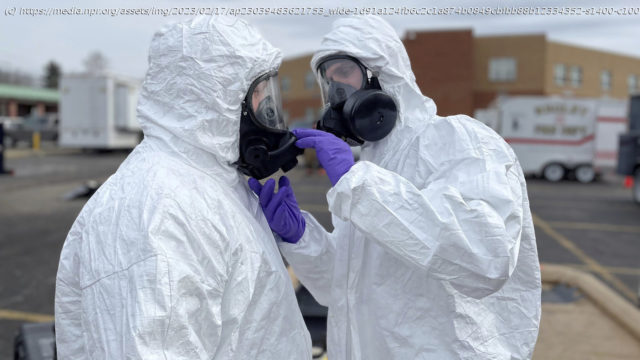Array
Questions linger over the potential health and environmental impact of the derailment of a train carrying hazardous chemicals near East Palestine, Ohio, earlier this month.
Some residents have reported headaches and rashes in the aftermath of the incident and have grown frustrated with the response from the rail company, Norfolk Southern, and public officials.
The Environmental Protection Agency maintains that the air is safe and that the agency is continuing to monitor the situation. The EPA says levels of the chemical causing the reportedly noxious smell are not high enough to impact the community’s health.
What happened in East Palestine is a cruel reminder of what can happen for millions of people who live near railways throughout the U.S., said Jennifer Sass, a senior scientist in the health and environment program of the the Natural Resources Defense Council, environmental nonprofit.
There is “a really big risk” of what occurred in East Palestine happening in other communities, Sass said.
“Rail lines crisscrossing the country are carrying hazardous materials, including materials that are explosive, and including materials that will become airborne if they’re released,” Sass said.
Just this week another Norfolk Southern train carrying at least one car with liquid chlorine derailed outside of Detroit. In that case, no chemicals were released, local public safety officials said.
But there are things that the industry, individuals and their communities can do to better protect themselves from potential hazards of similar chemical spills, Sass and other health and chemical safety experts told NPR.From 2015 to 2022, the Federal Railroad Administration investigated 110 train derailments with a hazmat spill
Though the risk of a crash and hazardous spill is deemed high by chemical safety experts, the Association of American Railroads (AAR) says “more than 99.9% of all hazmat moved by rail reaches its destination without a release caused by a train accident.”
The U.S. freight rail network runs on almost 140,000 route miles, according to the Federal Railroad Administration. And U.S. railroads “typically transport more than two million carloads of hazardous materials each year, including many chemicals that are considered hazardous,” according to the AAR.
From 2015 to 2022, the Federal Railroad Administration investigated 110 train derailments which resulted in a hazmat spill or release, according to data reviewed by NPR. No deaths were recorded in any of these derailments.
The agency doesn’t investigate every derailment, however, and it has certain criteria for doing so.
The National Transportation Safety Board, which is investigating the derailment in Ohio, doesn’t look into every derailment or other incident. That means the NTSB doesn’t keep a definitive listing of events it didn’t investigate, an agency spokesperson told NPR.
The risk, unfortunately, is not just with railways. There are chemicals also being transported by tanker trucks and by air, Nellie Brown, the director of workplace health and safety programs for the Worker Institute at Cornell University, notes.
“It’s not like, [accidents are] impossible. These things do happen. And when you’re looking at these things happening near residential areas, you naturally as a community need to have emergency response plans in place,” she said.
Home
United States
USA — Financial Risks for chemical spills are high, but here's how to protect yourself






